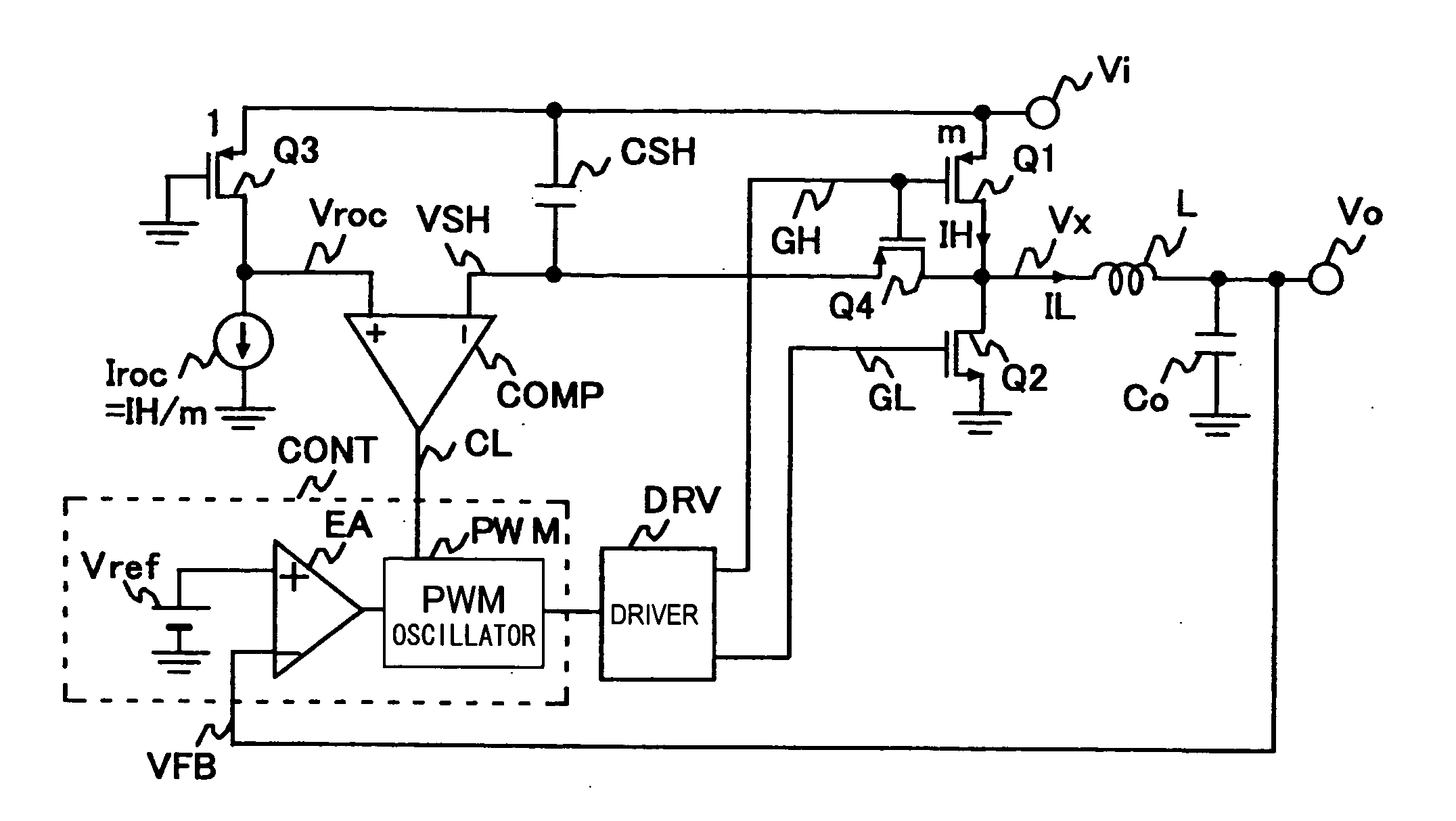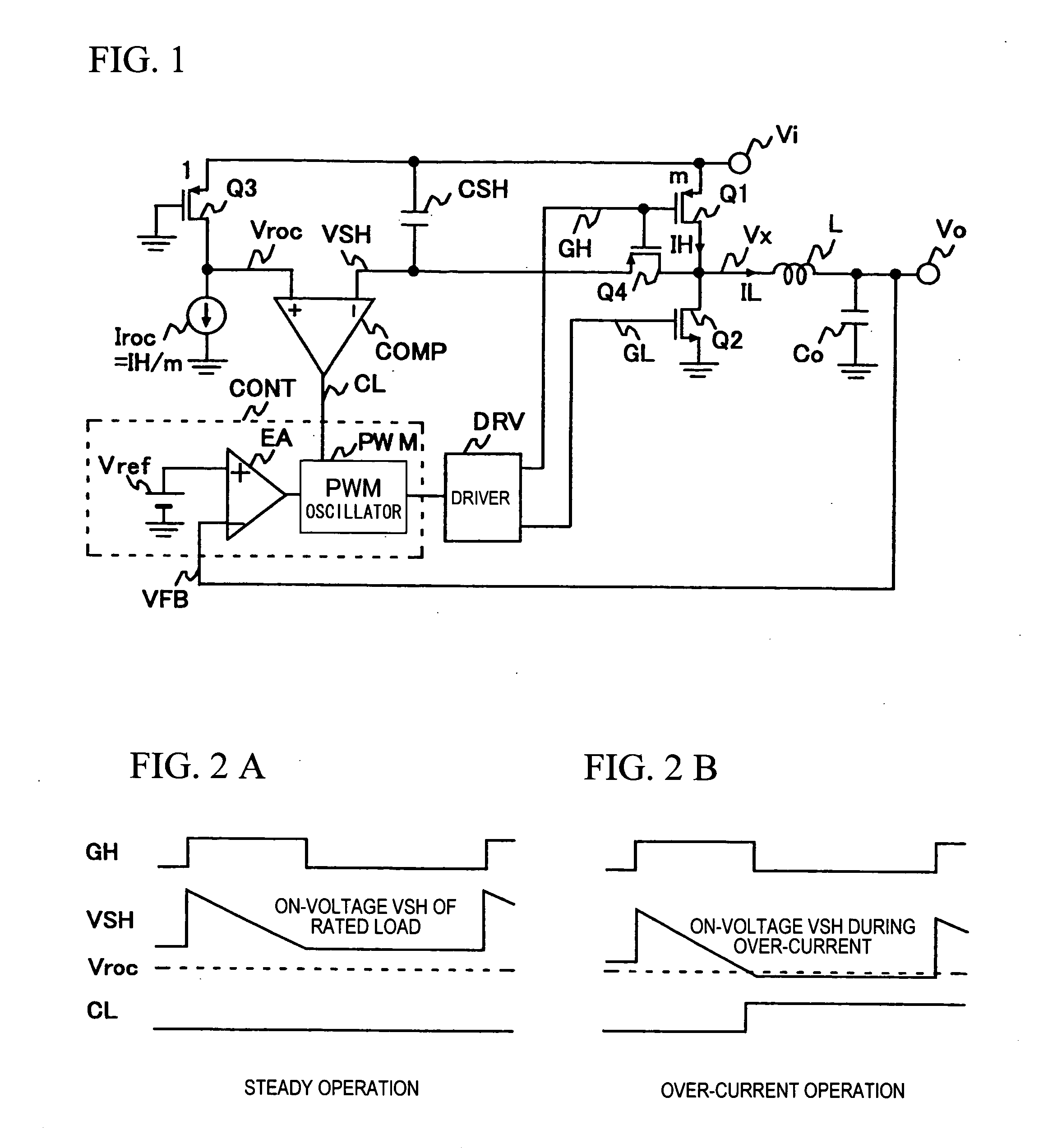Over-current detection circuit and method for power-supply device
- Summary
- Abstract
- Description
- Claims
- Application Information
AI Technical Summary
Benefits of technology
Problems solved by technology
Method used
Image
Examples
first embodiment
[0038]FIG. 1 shows a circuit diagram of a power-supply device containing an over-current detection circuit according to a first embodiment of the present invention. In FIG. 1, character Vi denotes an input terminal and character Vo denotes an output terminal. The input terminal Vi is connected to a high side power MOSFET (Q1), and a low side power MOSFET (Q2) is connected to ground. The midpoint between the power MOSFET (Q1) and the power MOSFET (Q2) is connected to an LC smoothing filter (power system output filter) comprising an inductor L and a capacitor Co, and the midpoint of the LC smoothing filter is connected to the output terminal Vo and one input (−) of an error amplifier EA.
[0039]The other input (+) to the error amplifier EA is connected to a reference voltage Vref. The output from the error amplifier EA is connected to a pulse-width modulation (PWM) oscillator PWM and a driver circuit DRV. The PWM is connected to the gate of the power MOSFET (Q1) and the power MOSFET (Q2...
second embodiment
[0054]FIG. 4 shows a circuit diagram of a power-supply device containing an over-current detection circuit according to a second embodiment of the present invention. In the figure, since a control circuit CONT and a driver DRV are the same as those shown in FIG. 1, the illustration thereof is omitted. FIG. 5 shows operating waveforms of a principal portion of the circuit shown in FIG. 4.
[0055]When the circuit shown in FIG. 4 and the circuit shown in FIG. 1 are compared, only the difference is that a resistor Rfil is connected in series with the switching MOSFET (Q4). Structured in this way, the present embodiment has the advantageous effect that, in addition to the advantageous effect of the first embodiment of the present invention, over-current detection can be achieved with a reduced ripple component and at a value closer to a DC voltage as the VSH in FIG. 5 shows, by smoothing the on-period waveform of the high power MOSFET (Q1) of the voltage VSH shown in FIG. 4 via a filtering...
third embodiment
[0056]In an over-current detection circuit according to a third embodiment of the present invention, an over-current value is detected not using a peak current. FIG. 6 shows a circuit diagram of a power-supply device containing an over-current detection circuit according to the third embodiment of the present invention. However, in the figure, since a control circuit CONT and a driver DRV are the same as those shown in FIG. 1, the illustration thereof is omitted. FIG. 7 shows operating waveforms of a principal portion of the circuit shown in FIG. 6.
[0057]The over-current detection circuit shown in FIG. 6 differs from the over-current detection circuits shown in FIGS. 1 and 4 in that a gate driving signal G4 of a switching MOSFET (Q4) is set separately from a gate driving signal GH of a high side power MOSFET (Q1). Further, as shown in FIG. 7, it is structured such that the on-period of the gate driving signal G4 (generating means will be described later) of the switching MOSFET (Q4)...
PUM
 Login to View More
Login to View More Abstract
Description
Claims
Application Information
 Login to View More
Login to View More - R&D
- Intellectual Property
- Life Sciences
- Materials
- Tech Scout
- Unparalleled Data Quality
- Higher Quality Content
- 60% Fewer Hallucinations
Browse by: Latest US Patents, China's latest patents, Technical Efficacy Thesaurus, Application Domain, Technology Topic, Popular Technical Reports.
© 2025 PatSnap. All rights reserved.Legal|Privacy policy|Modern Slavery Act Transparency Statement|Sitemap|About US| Contact US: help@patsnap.com



